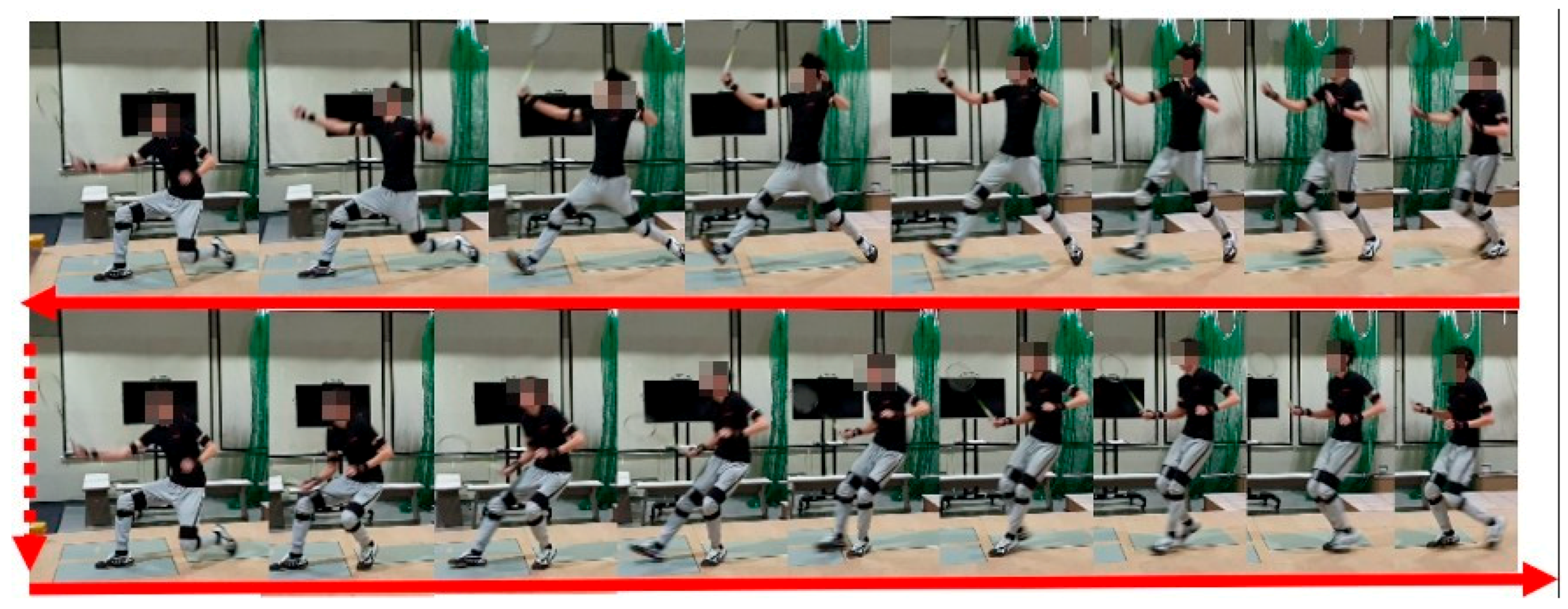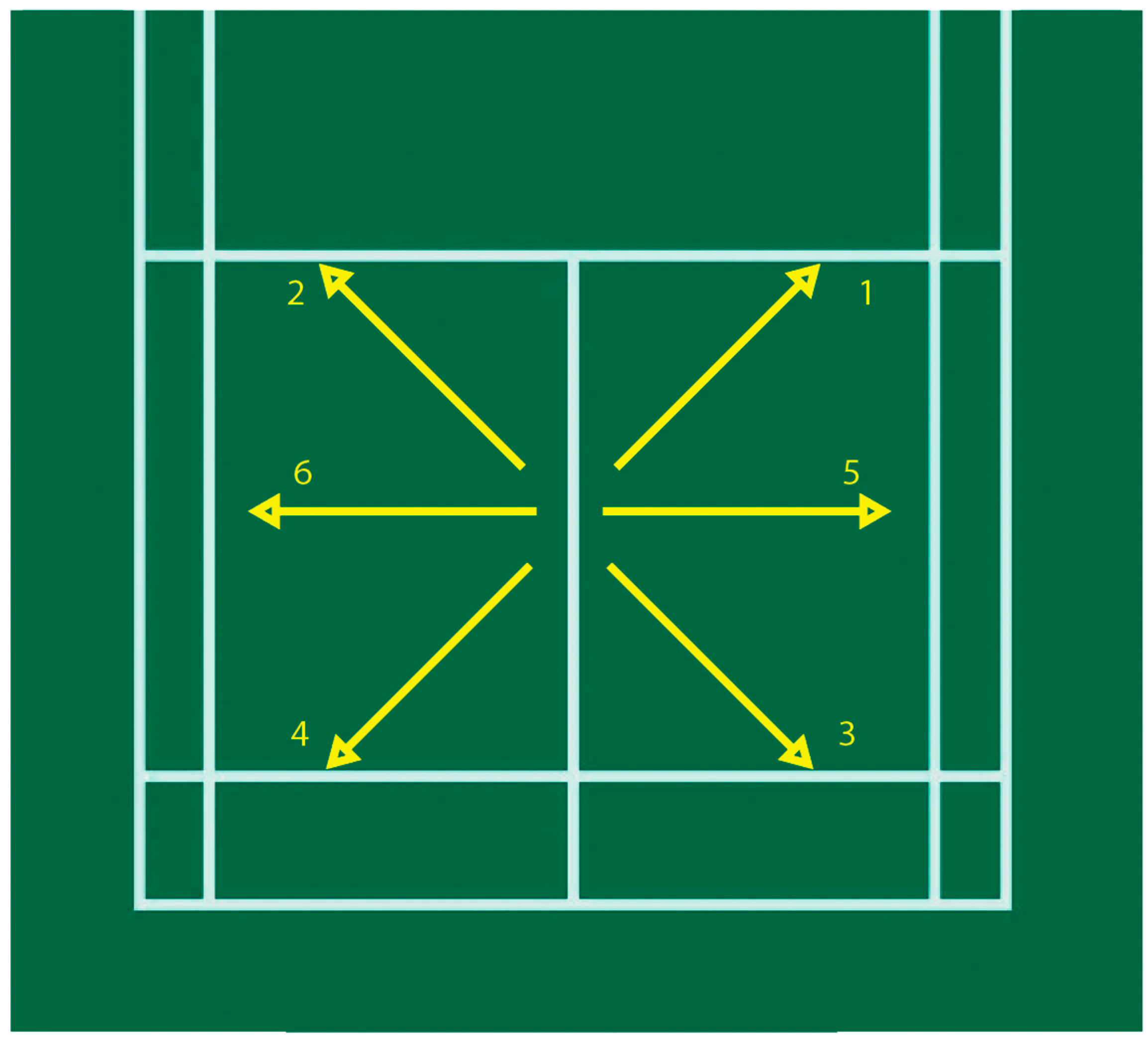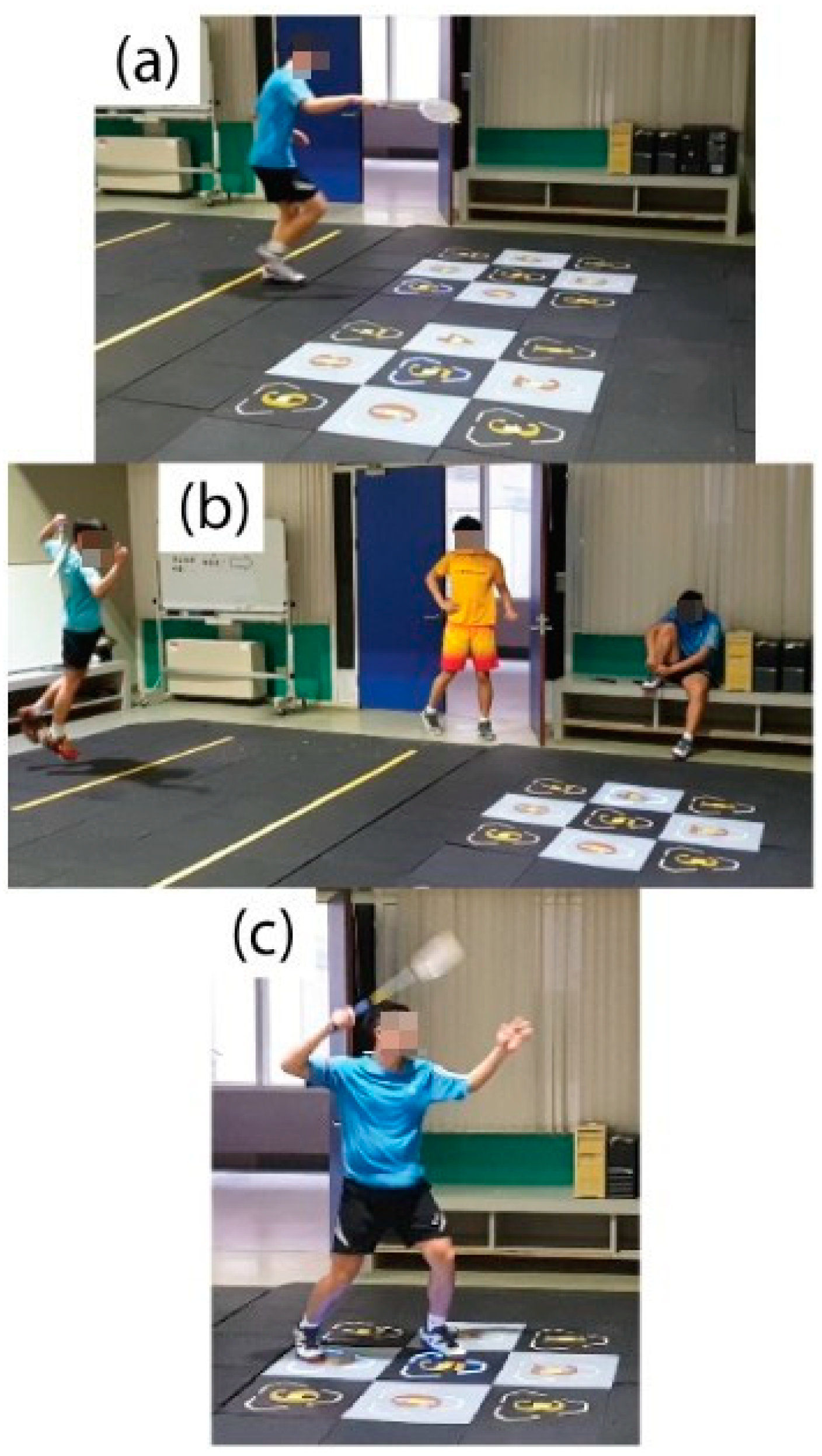Analysis of Functional Arch Support Insoles on the Biomechanics and Performance in Right-Forward Lunging Step of Badminton Players
Abstract
:1. Introduction
2. Materials and Methods
2.1. Participants
2.2. Procedures
- Test 1: Choose one day in the sports biomechanics laboratory to perform ten consecutive net stride tests (Figure 1); if there are five accumulated failures (step out of the force plate), cancel the test and re-administer the test. After excluding the first successful net stride, take four consecutive successful movements for analysis.
- Test 2: Choose one day to perform three consecutive six-point footwork tests on the badminton court (Figure 2) and measure the completion time.
- Test 3: Choose one day to perform a special movement test on a Sudoku intelligent sports mat. (1) Retrieve/stroke the ball at the left and right net (Figure 3a): the starting mat is 110 cm away from the target mat. Start sprinting to the right target mat and use right foot to do the net retrieve/stroke action at the random lighted place of the mat, run backward to the starting mat, go to the left target mat and step on the lighted place, then return. Repeat to the left and right mats 15 times each, 30 times in total, and measure the completion time. (2) Smash and retrieve/stroke the ball at the net (Figure 3b): the starting mat is 270 cm away from the target mat. Start sprinting after performing the smashing action, use the right foot to perform the net retrieve/stroke action at the random lighted place of the mat, run backward to the starting mat, and smash and retrieve/stroke the ball at the target mat again; repeat 15 times in total, and measure the completion time. (3) Smash at the front and back crossover step (Figure 3c): do this continuously; each time the smash is completed, the right foot steps onto the No. 5 mat, time 30 s, and measure the number of times completed.
2.3. Data Analysis
2.4. Statistics
3. Results
4. Discussion
5. Conclusions
Author Contributions
Funding
Informed Consent Statement
Data Availability Statement
Conflicts of Interest
References
- Agel, J.; Olson, D.E.; Dick, R.; Arendt, E.A. Descriptive epidemiology of collegiate women’s basketball injuries: National Collegiate Athletic Association Injury Surveillance System, 1988–1989 through 2003–2004. J. Athl. Train. 2007, 42, 202. [Google Scholar]
- Ou, T.M. Knee Injuries and Kinematics. Q. Chin. Phys. Educ. 2000, 14, 102–110. [Google Scholar] [CrossRef]
- Lin, Y.C.; Liu, H.; Shian, T.Y. Comparison of Lunge Kinetics and Kinematics between Barefoot and Badminton Shoes. Chin. J. Sports Biomech. 2018, 13, 86–97. [Google Scholar] [CrossRef]
- Kuntze, G.; Mansfield, N.; Sellers, W. A biomechanical analysis of common lunge tasks in badminton. J. Sports Sci. 2010, 28, 183–191. [Google Scholar] [CrossRef] [PubMed]
- Brughelli, M.; Cronin, J.; Levin, G.; Chaouachi, A. Understanding change of direction ability in sport. Sports Med. 2008, 38, 1045–1063. [Google Scholar] [CrossRef] [PubMed]
- Goral, K. Examination of agility performances of soccer players according to their playing positions. Sport J. 2015, 51, 1–11. [Google Scholar] [CrossRef]
- Mirkov, D.; Nedeljkovic, A.; Kukolj, M.; Ugarkovic, D.; Jaric, S. Evaluation of the reliability of soccer-specific field tests. J. Strength Cond. Res. 2008, 22, 1046–1050. [Google Scholar] [CrossRef]
- Sheppard, J.M.; Young, W.B. Agility literature review: Classifications, training and testing. J. Sports Sci. 2006, 24, 919–932. [Google Scholar] [CrossRef]
- Almonroeder, T.G.; Kernozek, T.; Cobb, S.; Slavens, B.; Wang, J.; Huddleston, W. Divided attention during cutting influences lower extremity mechanics in female athletes. Sports Biomech. 2019, 18, 264–276. [Google Scholar] [CrossRef] [PubMed]
- Mei, Q.; Gu, Y.; Fu, F.; Fernandez, J. A biomechanical investigation of right-forward lunging step among badminton players. J. Sports Sci. 2017, 35, 457–462. [Google Scholar] [CrossRef]
- Herbaut, A.; Delannoy, J.; Foissac, M. Injuries in French and Chinese regular badminton players. Sci. Sports 2018, 33, 145–151. [Google Scholar] [CrossRef]
- Kong, P.W.; Bagdon, M. Shoe preference based on subjective comfort for walking and running. J. Am. Podiatr. Med. Assoc. 2010, 100, 456–462. [Google Scholar] [CrossRef]
- Lam, W.K.; Ryue, J.; Lee, K.K.; Park, S.K.; Cheung, J.T.; Ryu, J. Does shoe heel design influence ground reaction forces and knee moments during maximum lunges in elite and intermediate badminton players? PLoS ONE 2017, 12, e0174604. [Google Scholar] [CrossRef] [PubMed]
- Huang, S.K.; Chen, Z.R.; Peng, S.T.; Li, S.Y.; Peng, H.T. The Influence of the Functional Insole with Arch Support on Pitching Performance of Baseball Pitchers. Sports Coach. Sci. 2016, 44, 39–46. [Google Scholar] [CrossRef]
- Chen, Z.R.; Chen, Y.R.; Cheng, H.Y.; Song, C.Y.; Chen, Y.H.; Peng, H.T. Effect of Arch Support Insole on Lower Extremity Loading and Kinematics During the Rebound. J. Phys. Educ. Sport Sci. 2016, 22, 33–42. [Google Scholar] [CrossRef]
- Su, C.H.; Tai, W.H.; Peng, H.T. Effects of Arch Support Insoles on Tennis Strokes. J. Sports Perform. 2016, 3, 41–48. [Google Scholar] [CrossRef]
- Chen, H.W.; Chen, S.Y.; Kim, K.; Peng, H.T. Effect of arch support insoles on the sport biomechanical parameters of Pétanque players when shooting. In Proceedings of the 7th Asian Society of Sport Biomechanics Conference, Jeju, Korea, 19 October 2018. [Google Scholar]
- Aaltonen, S.; Karjalainen, H.; Heinonen, A.; Parkkari, J.; Kujala, U.M. Prevention of sports injuries: Systematic review of randomized controlled trials. Arch. Intern. Med. 2007, 167, 1585–1592. [Google Scholar] [CrossRef]
- Bonanno, D.R.; Landorf, K.B.; Munteanu, S.E.; Murley, G.S.; Menz, H.B. Effectiveness of foot orthoses and shock-absorbing insoles for the prevention of injury: A systematic review and meta-analysis. Br. J. Sports Med. 2017, 51, 86–96. [Google Scholar] [CrossRef]
- Goel, R.; Kofman, I.; Jeevarajan, J.; De Dios, Y.; Cohen, H.S.; Bloomberg, J.J.; Mulavara, A.P. Using Low Levels of Stochastic Vestibular Stimulation to Improve Balance Function. PLoS ONE 2015, 10, e0136335. [Google Scholar] [CrossRef]
- Kristianslund, E.; Krosshaug, T.; van den Bogert, A.J. Effect of low pass filtering on joint moments from inverse dynamics: Implications for injury prevention. J. Biomech. 2012, 45, 666–671. [Google Scholar] [CrossRef]
- Devita, P.; Fellin, R.E.; Seay, J.F.; Ip, E.; Stavro, N.; Messier, S.P. The Relationships between Age and Running Biomechanics. Med. Sci. Sports Exerc. 2016, 48, 98–106. [Google Scholar] [CrossRef]
- Lee, Y.M.; Lee, H.J. Effects of Different Jump-landing Directions on Sagittal Plane Kinematics, Kinetics and Energetics at Lower Extremity Joints. Phys. Educ. J. 2013, 46, 33–43. [Google Scholar] [CrossRef]
- Laughlin, W.A.; Weinhandl, J.T.; Kernozek, T.W.; Cobb, S.C.; Keenan, K.G.; O’Connor, K.M. The effects of single-leg landing technique on ACL loading. J. Biomech. 2011, 44, 1845–1851. [Google Scholar] [CrossRef] [PubMed]
- Mcnitt-Gray, J.L. Kinematics and impulse characteristics of drop landings from three heights. Int. J. Sport Biomech. 1991, 7, 201–224. [Google Scholar] [CrossRef]
- Salci, Y.; Kentel, B.B.; Heycan, C.; Akin, S.; Korkusuz, F. Comparison of landing maneuvers between male and female college volleyball players. Clin. Biomech. 2004, 19, 622–628. [Google Scholar] [CrossRef]
- Yu, B.; Lin, C.F.; Garrett, W.E. Lower extremity biomechanics during the landing of a stop-jump task. Clin. Biomech. 2006, 21, 297–305. [Google Scholar] [CrossRef]
- Blackburn, J.T.; Padua, D.A. Influence of trunk flexion on hip and knee joint kinematics during a controlled drop landing. Clin. Biomech. 2008, 23, 313–319. [Google Scholar] [CrossRef] [PubMed]
- Kuntze, G.; Sellers, W.I.; Mansfield, N. Bilateral ground reaction forces and joint moments for lateral sidestepping and crossover stepping tasks. J. Sports Sci. Med. 2009, 8, 1–8. [Google Scholar] [PubMed]
- Wei, F.; Fong, D.T.; Chan, K.M.; Haut, R.C. Estimation of ligament strains and joint moments in the ankle during a supination sprain injury. Comput. Methods Biomech. Biomed. Eng. 2015, 18, 243–248. [Google Scholar] [CrossRef] [PubMed]
- Fox, A.S. Change-of-direction biomechanics: Is what’s best for anterior cruciate ligament injury prevention also best for performance. Sports Med. 2018, 48, 1799–1807. [Google Scholar] [CrossRef] [PubMed]



| Parameters | FLI | ASI | % | p | ES |
|---|---|---|---|---|---|
| Kinematics (Test 1) | |||||
| Support time (s) | 0.60 ± 0.11 | 0.59 ± 0.15 | −1.7 | 0.506 | 0.16 |
| The moment of landing | |||||
| RhipF (deg) | 42.58 ± 10.09 | 44.75 ± 14.64 | 5.1 | 0.17 | 0.32 |
| RkneeF (deg) | 31.37 ± 17.22 | 35.85 ± 20.19 | 14.3 | 0.523 | 0.15 |
| RfootI (deg) | 13.97 ± 7.13 | 12.46 ± 4.8 | −10.8 | 0.326 | 0.25 |
| RfootPF (deg) | 12.67 ± 9.56 | 5.37 ± 15.38 | −57.6 | 0.272 | 0.32 |
| Peak value during support phase | |||||
| RhipF (deg) | 60.08 ± 13.82 | 63.09 ± 10.70 | 5.0 | 0.028 * | 0.52 |
| RkneeF (deg) | 58.79 ± 10.86 | 60.41 ± 13.87 | 2.8 | 0.372 | 0.21 |
| RfootI (deg) | 23.85 ± 8.11 | 20.68 ± 7.87 | −13.3 | 0.013 * | 0.59 |
| RfootPF (deg) | 36.07 ± 15.94 | 31.1 ± 12.38 | −13.8 | 0.332 | 0.24 |
| Kinetics (Test 1) | |||||
| PvGRF (BW) | 2.16 ± 0.30 | 2.16 ± 0.32 | 0 | 0.948 | 0.02 |
| PhGRF (BW) | 1.23 ± 0.24 | 1.22 ± 0.20 | −0.8 | 0.845 | 0.05 |
| VLR (BW/s) | 26.12 ± 12.69 | 26 ± 12.26 | −0.5 | 0.828 | 0.05 |
| HLR (BW/s) | 16.28 ± 8.28 | 15.82 ± 6.96 | −2.8 | 0.711 | 0.09 |
| Performance | |||||
| Test 2 (s) | 36.97 ± 3.00 | 36.34 ± 3.12 | −1.7 | 0.210 | 0.29 |
| Test 3 (1) (s) | 63.85 ± 13.4 | 62.18 ± 11.47 | −2.7 | 0.372 | 0.21 |
| Test 3 (2) (s) | 53.31 ± 8.53 | 52.06 ± 10.51 | −2.3 | 0.777 | 0.06 |
| Test 3 (3) (times) | 30.6 ± 2.96 | 31.5 ± 3.96 | 2.9 | 0.184 | 0.31 |
Publisher’s Note: MDPI stays neutral with regard to jurisdictional claims in published maps and institutional affiliations. |
© 2022 by the authors. Licensee MDPI, Basel, Switzerland. This article is an open access article distributed under the terms and conditions of the Creative Commons Attribution (CC BY) license (https://creativecommons.org/licenses/by/4.0/).
Share and Cite
Chen, H.-W.; Peng, H.-T.; Wei, Y. Analysis of Functional Arch Support Insoles on the Biomechanics and Performance in Right-Forward Lunging Step of Badminton Players. Int. J. Environ. Res. Public Health 2022, 19, 11210. https://doi.org/10.3390/ijerph191811210
Chen H-W, Peng H-T, Wei Y. Analysis of Functional Arch Support Insoles on the Biomechanics and Performance in Right-Forward Lunging Step of Badminton Players. International Journal of Environmental Research and Public Health. 2022; 19(18):11210. https://doi.org/10.3390/ijerph191811210
Chicago/Turabian StyleChen, Hung-Wen, Hsien-Te Peng, and Yan Wei. 2022. "Analysis of Functional Arch Support Insoles on the Biomechanics and Performance in Right-Forward Lunging Step of Badminton Players" International Journal of Environmental Research and Public Health 19, no. 18: 11210. https://doi.org/10.3390/ijerph191811210
APA StyleChen, H.-W., Peng, H.-T., & Wei, Y. (2022). Analysis of Functional Arch Support Insoles on the Biomechanics and Performance in Right-Forward Lunging Step of Badminton Players. International Journal of Environmental Research and Public Health, 19(18), 11210. https://doi.org/10.3390/ijerph191811210






